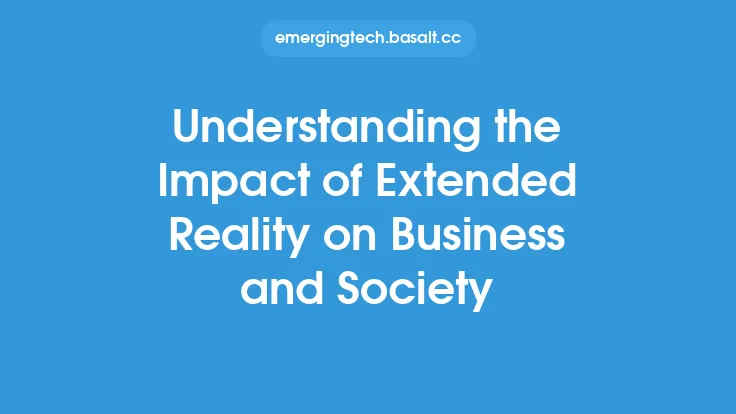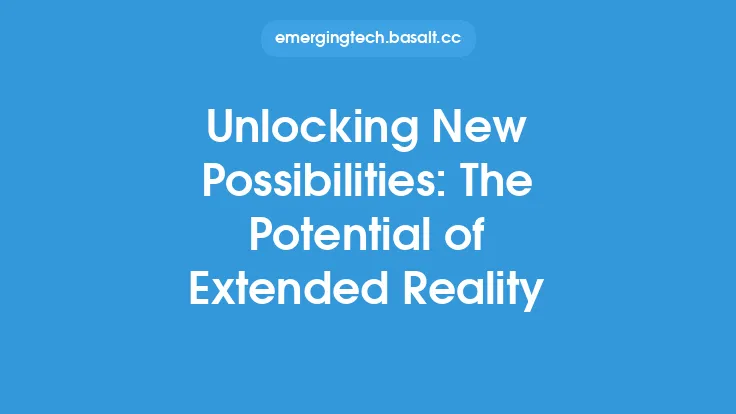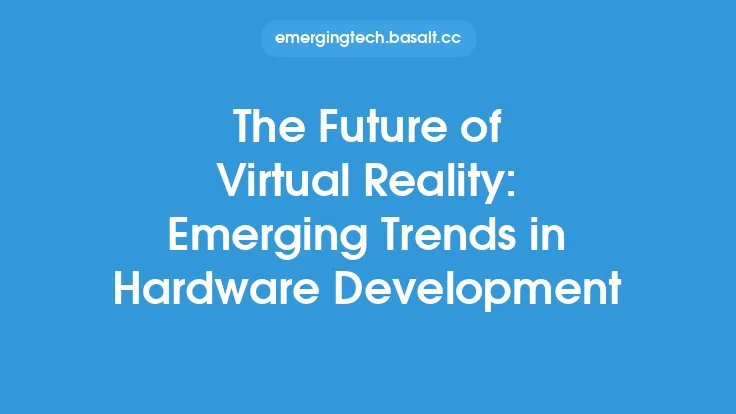The concept of Extended Reality (XR) has been gaining significant attention in recent years, and its potential to revolutionize the way humans interact with each other and their surroundings is vast. XR is an umbrella term that encompasses Virtual Reality (VR), Augmented Reality (AR), and Mixed Reality (MR), each providing a unique set of capabilities that can enhance and transform various aspects of our lives. As we delve into the future of human interaction, it's essential to explore the possibilities and implications of XR and its potential to reshape the way we live, work, and play.
Introduction to Extended Reality
Extended Reality is a technology that alters the perception of reality by adding virtual or digital elements to the real world. This can be achieved through various devices, such as head-mounted displays, smartphones, or tablets, which provide an immersive and interactive experience. The primary goal of XR is to create a seamless and intuitive interface between humans and machines, enabling new forms of communication, collaboration, and entertainment. By leveraging XR, individuals can engage with virtual objects, environments, and other people in a more natural and immersive way, which can lead to increased productivity, improved learning outcomes, and enhanced overall experiences.
Technical Aspects of Extended Reality
From a technical perspective, XR relies on several key components, including displays, sensors, and software. The display is the primary interface through which users interact with the virtual environment, and it can range from simple screens to complex head-mounted displays. Sensors, such as cameras, microphones, and accelerometers, provide essential data about the user's surroundings and movements, allowing the system to track and respond to their actions. The software component is responsible for rendering the virtual environment, handling user input, and providing a seamless and immersive experience. Some of the key technologies used in XR include computer vision, machine learning, and real-time rendering, which enable the creation of sophisticated and interactive virtual worlds.
Applications of Extended Reality
The applications of XR are diverse and widespread, spanning various industries and domains. In the field of education, XR can be used to create interactive and immersive learning experiences, allowing students to engage with complex concepts and simulations in a more intuitive and effective way. In healthcare, XR can be used for training medical professionals, treating mental health disorders, and providing patients with immersive therapy experiences. In the entertainment industry, XR can be used to create new forms of immersive storytelling, such as virtual reality movies and games, which can provide a more engaging and interactive experience for audiences. Additionally, XR can be used in fields such as architecture, engineering, and product design, allowing professionals to create and interact with virtual models and prototypes in a more intuitive and collaborative way.
Human-Computer Interaction in Extended Reality
One of the primary benefits of XR is its ability to enable new forms of human-computer interaction. By providing an immersive and interactive environment, XR can facilitate more natural and intuitive forms of communication between humans and machines. This can be achieved through various interfaces, such as voice commands, gestures, and eye tracking, which allow users to interact with virtual objects and environments in a more seamless and intuitive way. Additionally, XR can enable new forms of collaboration and social interaction, allowing individuals to engage with each other in virtual environments and share experiences in a more immersive and interactive way.
Social Implications of Extended Reality
As XR becomes more widespread and integrated into our daily lives, it's essential to consider its social implications. One of the primary concerns is the potential for XR to exacerbate social isolation and decrease face-to-face interaction. However, XR can also be used to facilitate social connection and community building, allowing individuals to engage with each other in virtual environments and share experiences in a more immersive and interactive way. Additionally, XR can be used to promote empathy and understanding, allowing individuals to experience different perspectives and environments in a more immersive and interactive way. Ultimately, the social implications of XR will depend on how it is designed and used, and it's essential to consider these implications as we develop and integrate XR into our daily lives.
Future Developments in Extended Reality
As XR continues to evolve and improve, we can expect to see significant advancements in the coming years. One of the primary areas of development is the creation of more sophisticated and immersive virtual environments, which can be achieved through advancements in computer vision, machine learning, and real-time rendering. Additionally, we can expect to see the development of more advanced interfaces, such as brain-computer interfaces and haptic feedback systems, which can enable more natural and intuitive forms of human-computer interaction. Furthermore, we can expect to see the integration of XR with other technologies, such as artificial intelligence and the Internet of Things, which can enable new forms of automation, collaboration, and innovation.
Challenges and Limitations of Extended Reality
Despite the potential of XR, there are several challenges and limitations that need to be addressed. One of the primary challenges is the cost and accessibility of XR technology, which can be prohibitively expensive for many individuals and organizations. Additionally, there are concerns about the potential health and safety risks of XR, such as eye strain, headaches, and social isolation. Furthermore, there are challenges related to the development of XR content, which can be time-consuming and require significant expertise and resources. Ultimately, addressing these challenges and limitations will be essential to realizing the full potential of XR and ensuring its widespread adoption and integration into our daily lives.
Conclusion
In conclusion, the future of human interaction is likely to be shaped by the development and integration of Extended Reality. By providing an immersive and interactive environment, XR can facilitate new forms of communication, collaboration, and entertainment, and enable more natural and intuitive forms of human-computer interaction. As XR continues to evolve and improve, we can expect to see significant advancements in the coming years, including the creation of more sophisticated and immersive virtual environments, the development of more advanced interfaces, and the integration of XR with other technologies. However, it's essential to consider the challenges and limitations of XR, including its cost and accessibility, potential health and safety risks, and challenges related to content development. By addressing these challenges and limitations, we can ensure the widespread adoption and integration of XR into our daily lives, and realize its full potential to transform and enhance human interaction.





